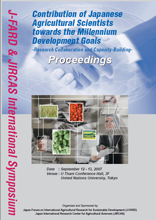International agricultural research centers and Japan

The world is divided, rich and poor, and that disparity continues to increase. This is especially true for
Sub-Sahara Africa. On the other hand, the world is interdependent. Plant or animal diseases originating in one
country can easily affect other countries. Avian fl u and mad cow disease (BSE) are good examples. Major
harvest losses in some countries would affect world food prices and availability (hence food security). The
use of food crops for biofuels, driven by a global move toward renewable energy, affects food availability
and prices worldwide.
International Agricultural Research Centers (IARCs) and Japan share a common vision for the role of
agricultural research in the world. They both believe in the importance of agriculture as an engine of socioeconomic
development. The world needs to be food-secure. We want a peaceful and prosperous world.
Japan has the second largest economy in the world and its investment in research and development
is also the second largest. In fact, the total amount of research money spent by Japan (private and public) is
bigger than the total sum spent by 44 countries in Sub-Sahara Africa. Japan is endowed with huge resources
of human capital, knowledge and technology that have potential value for developing countries.
There are some good examples of the application of Japanese agricultural research talent and products
for developing countries through collaborative research schemes between Japan and IARCs. The use of
DREB (dehydration responsive element binding protein) for developing drought-tolerant crops represents
an excellent test case of innovative, win-win, collaborative research with direct implications for developing
countries. Biological nitrification inhibition (BNI) for increased efficiency of plant nitrogen use and for
reduced emissions of nitrous oxide, a powerful greenhouse gas, is another emerging example of collaboration
with global impacts.
Many research and educational organizations in Japan have set up offi ces for research and technology
transfer to link their research outcomes to practical applications. Their view, however, is often limited to
the Japanese market. By expanding this view to the developing world there are many more opportunities
for practical applications. The major function of IARCs’ is to link the needs of the resource poor with
technological innovations and practical solutions for improving their livelihoods. Therefore active linkages
between Japanese organizations and IARCs would enhance the probability that Japanese knowledge and
technology would be properly linked with the needs of the poor. This, in turn, benefi ts Japan which depends
on large food imports and a peaceful and prosperous world for its own food and national security.
IARCs also present excellent opportunities for Japanese students and scientists to get direct hands-on
experience in international agriculture. Experience with IARCs would expand the horizons of students and
scientists and offer opportunities to identify interesting and meaningful research challenges.
| 刊行年月日 | |
|---|---|
| 作成者 | Masa Iwanaga |
| 公開者 | Japan International Research Center for Agricultural Sciences |
| オンライン掲載日 | |
| 号 | 2007 |
| 開始ページ | 41 |
| 終了ページ | 45 |
| 権利 | Japan International Research Center for Agricultural Sciences |
| 言語 | eng |
